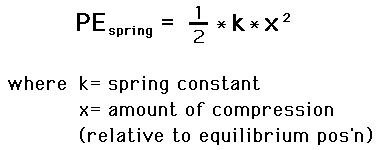A ball with a mass of #120 g# is projected vertically by a spring loaded contraption. The spring in the contraption has a spring constant of #15 (kg)/s^2# and was compressed by #3/5 m# when the ball was released. How high will the ball go?
2 Answers
The height reached by the ball is
Explanation:

The spring constant is
The compression of the spring is
The potential energy stored in the spring is
This potential energy will be converted to kinetic energy when the spring is released and to potential energy of the ball
Let the height of the ball be
The acceleration due to gravity is
Then ,
The potential energy of the ball is
Mass of the ball is
The height reached by the ball is
Explanation:
Assuming spring to be perfectly elastic, when the ball is released, the entire elastic energy of spring
Where,
hence, we have
Now, using third equation of motion:
For the motion against gravity, we have
hence, we have


